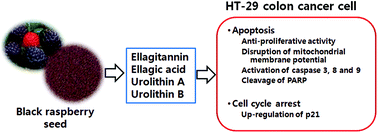Chemopreventive activity of ellagitannins and their derivatives from black raspberry seeds on HT-29 colon cancer cells
Abstract
Black raspberry (BRB) seeds are a major waste product after fruit processing. The seeds are abundant in ellagitannins (ET), a class of hydrolysable tannins, which are hydrolyzed to ellagic acid (EA) and further metabolized to urolithin A (UA) and urolithin B (UB), known to be bioavailable in the colon and the prostate. In this study, the anti-cancer activities of these compounds were evaluated on HT-29 colon cancer cells. ET, EA, UA and UB inhibited the proliferation of the cancer cells. EA caused a slight, but significant cell cycle arrest at the G1 phase, and urolithins caused cell cycle arrest at the G2/M phase and upregulated p21 expression. Apoptotic cells were detected by Annexin V-FITC/PI assay when treated with the compounds. Disruption in mitochondrial membrane potential and activation of caspases 8 and 9 suggest that both extrinsic and intrinsic apoptotic pathways may be involved. Activation of caspase 3 and cleavage of PARP further confirmed the induction of the apoptosis. ET, EA, UA and UB showed anti-cancer activity by arresting the cell cycle and inducing apoptosis on HT-29 human colon cancer cells. This study suggests that the BRB seeds could be a potential source of anti-cancer ET.


 Please wait while we load your content...
Please wait while we load your content...